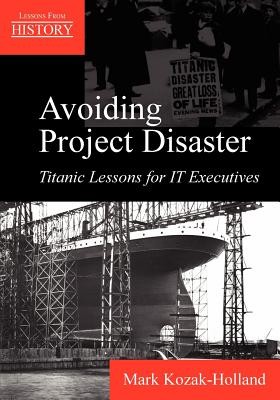
- We will send in 10–14 business days.
- Author: Mark Kozak-Holland
- Publisher: Multi-Media Publications Inc.
- ISBN-10: 1895186730
- ISBN-13: 9781895186734
- Format: 17.8 x 25.4 x 1.7 cm, minkšti viršeliai
- Language: English
- SAVE -10% with code: EXTRA
Reviews
Description
Titanic's maiden voyage was a disaster waiting to happen as a result of the compromises made in the project. This book explores how non-IT executives can take lessons from a nuts-and-bolts construction project like Titanic and use those lessons to ensure the right approach to developing on-line operations. Looking at this historical project as a model cuts away the layers of IT jargon and complexity. Avoiding Project Disaster is about delivering IT projects in a world where on-time and on-budget is not enough. It will help you successfully maneuver through the ice floes of IT project management in an industry with a notoriously high project failure rate. This book outlines the stages involved in creating mission critical services and the underlying environment to support these. Specifically, the book provides the non-technical manager a step-by-step guide to the deliverables that the IT department should produce at each stage of the creation process. The book enlightens the non-technical manager to the fact that a considerable part of the effort is in realigning the organization and procedures rather than technology. Knowing the rationale for and the timing of deliverables enables the non-IT manager to be a full participant in the creation process. The book leaves the reader with a simple philosophy: namely, focus your IT investments on getting your organization and procedures aligned and you can get best-in-class results from your technology. The book uses close to 90 figures and more than 40 tables for clarification of major concepts through detailed models, e.g., Change Management (9-step model) and Problem Management (4-step model).
EXTRA 10 % discount with code: EXTRA
The promotion ends in 22d.12:28:12
The discount code is valid when purchasing from 10 €. Discounts do not stack.
- Author: Mark Kozak-Holland
- Publisher: Multi-Media Publications Inc.
- ISBN-10: 1895186730
- ISBN-13: 9781895186734
- Format: 17.8 x 25.4 x 1.7 cm, minkšti viršeliai
- Language: English English
Titanic's maiden voyage was a disaster waiting to happen as a result of the compromises made in the project. This book explores how non-IT executives can take lessons from a nuts-and-bolts construction project like Titanic and use those lessons to ensure the right approach to developing on-line operations. Looking at this historical project as a model cuts away the layers of IT jargon and complexity. Avoiding Project Disaster is about delivering IT projects in a world where on-time and on-budget is not enough. It will help you successfully maneuver through the ice floes of IT project management in an industry with a notoriously high project failure rate. This book outlines the stages involved in creating mission critical services and the underlying environment to support these. Specifically, the book provides the non-technical manager a step-by-step guide to the deliverables that the IT department should produce at each stage of the creation process. The book enlightens the non-technical manager to the fact that a considerable part of the effort is in realigning the organization and procedures rather than technology. Knowing the rationale for and the timing of deliverables enables the non-IT manager to be a full participant in the creation process. The book leaves the reader with a simple philosophy: namely, focus your IT investments on getting your organization and procedures aligned and you can get best-in-class results from your technology. The book uses close to 90 figures and more than 40 tables for clarification of major concepts through detailed models, e.g., Change Management (9-step model) and Problem Management (4-step model).


Reviews